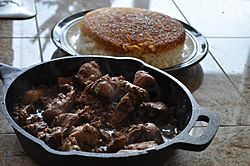Fesenjān facts for kids

A bowl of chicken fesenjān, with Persian rice topped by tahdig
|
|
| Type | Stew |
|---|---|
| Course | Main course |
| Place of origin | |
| Region or state | Northern Iran (Gilan and Mazandaran) |
| Associated national cuisine | |
| Created by | Iranians (Talysh ,Gilaks and Mazandaranis) |
| Main ingredients | Pomegranate juice, walnuts, poultry (duck or chicken) |
Fesenjān (Persian: فسنجان), also called fesenjoon, is a yummy Iranian stew. It comes from Northern Iran.
Contents
What is Fesenjān?
Fesenjān gets its special taste from pomegranate paste and ground walnuts. It also has spices like turmeric, cinnamon, and sometimes orange peel.
This stew is usually made with poultry like duck or chicken. You can also find it made with small balls of ground meat or pieces of lamb.
Sweet or Sour?
Fesenjān can taste either sweet or sour, depending on the recipe! If it's too sour, cooks might add a little sugar or fried onions to make it sweeter.
How to Eat Fesenjān
People usually eat Fesenjān with Iranian white or yellow rice, which is called polo or chelo. It's a hearty and delicious meal.
Fesenjān and Yaldā Night
Fesenjān is a special dish often served during Yaldā Night celebrations. This is an ancient Iranian festival that celebrates the longest night of the year.
History of Fesenjān
The first time Fesenjān was written about was in a cookbook from 1881 called Sofra-ye at'ema. This book listed ten different kinds of Fesenjān!
Different Kinds of Fesenjān
Back then, Fesenjān wasn't just made with walnuts. There were versions with almonds, eggplant, kidney beans, quince, potatoes, carrots, pumpkin, fish, and even yogurt! Today, the walnut version is the most common.
The first dictionary to mention Fesenjān called it fasūjan. It said that this tasty stew first came from Gilan, a region in Iran.
Fesenjān in Culture
Fesenjān is a fancy dish that people often save for special parties and celebrations. It's sometimes called "a rich man's dish." There's even a Persian saying that means "he acts like he's had partridge and fesenjān," which means someone is showing off!
"Hot" and "Cold" Foods
In traditional Iranian culture, foods are sometimes thought of as "hot" or "cold." This doesn't mean their temperature, but how they affect your body. Walnuts are considered a "hot" food, so Fesenjān is also seen as "hot." To balance this, some people add "cold" foods like coriander or peeled pumpkin. Pumpkin can also make the stew a bit sweeter!
See also
 In Spanish: Fesenyán para niños
In Spanish: Fesenyán para niños

